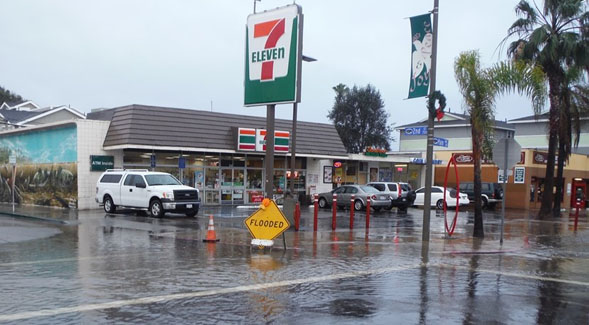Researchers Take on Imperial Beach Flooding
The team received a $500,000 grant and support from the City Council to combat the problem.

With the help of a $500,000, three-year grant from the National Science Foundation, Hassan Davani and Megan Welsh are teaming with the University of California, San Diego’s Scripps Institution of Oceanography to determine whether rain barrels can offset geographic problems that leave the border community vulnerable to flooding.
“In underserved communities on shallow aquifers like Imperial Beach, their infrastructure is occupied by groundwater, they have no capacity to drain stormwater,” said Davani, a civil engineer and assistant professor in water resources engineering. “We call this compound flooding because multiple factors are happening at the same time.”
Imperial Beach is bordered by San Diego Bay to the north, Otay River to the east, the Tijuana River Estuary to the south, and the Pacific Ocean. A combination of issues that include rising sea and groundwater tables and inundation by waves leave the city and any underground infrastructure particularly vulnerable to flooding, especially after heavy rain, and the clock is ticking.
Davani and his team plan to study the interaction of groundwater and drainage in Imperial Beach to better understand the infrastructure issues. They believe part of the solution to this issue may lie with Imperial Beach residents if they can be persuaded to collect rainwater that would otherwise drain into streets.
“We want to address the environmental impacts of climate change and try to implement the green infrastructure solutions that are going to come out of this research,” said Welsh, an associate professor and social scientist in the School of Public Affairs.
“Rainwater harvesting could be one of many solutions that can try to help keep at least some of the stormwater that we would receive from entering into the underground infrastructure and contributing to the compound flooding issue.”
Rain barrels, said to date at least as far back as 6th century Turkey, would also be a more green, less costly, and more feasible alternative than large-scale engineering approaches such as pumping, the team notes.
Not only is this flooding a matter of water quantity, but also quality. When the bordering region of Tijuana experiences flooding, the Tijuana River overflows often resulting in polluted untreated water running through the infrastructure of Imperial Beach, occasionally causing flooding of polluted water at high tide conditions.
Around 70% of Imperial Beach Residents rent their homes, so the team is tasked with figuring out how to get residents involved and install rain barrels. The team is considering studying the acceptability of incentives, spreading awareness, and garnering support from landlords.
“Our solutions involve infrastructure above the surface,” Davani said. “Rain barrels are your most ancient way of collecting water. By harvesting rainfall from rooftops, it’s helping with the water conservation side. It reduces your demands, you can use the water for toilet flushing, irrigation, and laundry, the needs that don't have huge needs for treatment.”
Davani is developing software models that could predict how much compound flooding can be prevented if a certain percentage of the residents use rain barrels, providing real-time evidence that their solution can work and convincing more of the community to join.
Davani and his team presented their ideas and findings to the Imperial Beach City Council meeting on Sept. 1, where they gained praise and support from the Council, including Imperial Beach Mayor Serge Dedina.
Dedina explained that the project is a functional approach to the area’s flooding problems and expressed his excitement for what the project may yield.
“We look forward to getting lots of data,” Dedina said. “We appreciate you all for being great scientists and being willing to engage with the community. Thank you.”



